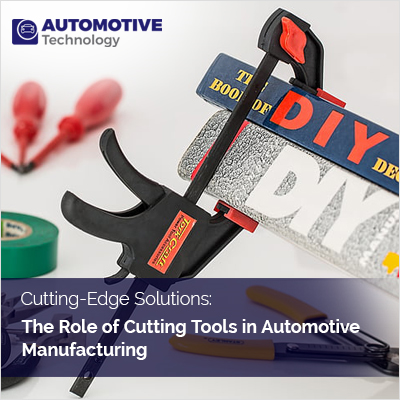Cutting-Edge Solutions: The Role of Cutting Tools in Automotive Manufacturing

Cutting-edge solutions play a crucial role in enhancing efficiency, precision, and overall productivity in automotive manufacturing, and cutting tools are at the forefront of these advancements. The manufacturing process in the automotive industry involves shaping and assembling various materials, such as metals and composites, to create intricate components. Cutting tools are essential in tasks like milling, turning, drilling, and grinding, contributing significantly to the final product's quality and performance.
Here are several key aspects highlighting the role of cutting tools in automotive manufacturing:
Material Variety:
Versatility in cutting tools is paramount due to the diverse materials used in automotive manufacturing. Each material, whether it's aluminum, steel, titanium, or advanced composites, possesses unique properties. Cutting tools need to adapt to variations in hardness, thermal conductivity, and abrasiveness. For instance, machining aluminum may require different cutting speeds and tool geometries compared to working with hardened steel. The ability of cutting tools to handle this material diversity ensures efficiency in the manufacturing process.
|
Read More: Cutting Edge Excellence: Tools Transforming Automotive Production |
Precision Machining:
In the automotive industry, achieving precision in machining is paramount, especially when crafting components with stringent tolerances and intricate designs. Cutting tools, equipped with advanced features like high-speed machining and multi-axis capabilities, provide manufacturers with the means to meet these precision requirements. The importance of precision extends beyond the visual appeal of components; it directly impacts the functionality and safety of the final automotive products. By embracing cutting-edge tools, manufacturers can consistently produce top-tier, precision-engineered parts, ensuring the overall quality and reliability of the end products.
| Also Read: Precision in Motion: The Evolution of Cutting Tools in the Automotive Industry |
Tool Coatings and Materials:
Coatings and materials hold a pivotal role in enhancing the effectiveness and durability of cutting tools. Durable materials such as carbide, ceramic, and diamond-like carbon contribute to minimizing wear, leading to prolonged tool life. These coatings also play a crucial role in preserving the sharpness of cutting edges, ensuring a consistent and efficient machining process. Moreover, they offer essential heat resistance, a critical factor in managing elevated temperatures during high-speed machining. The incorporation of advanced materials not only enhances the overall reliability but also strengthens the performance of cutting tools in the challenging environment of automotive manufacturing.
High-Speed Machining (HSM):
High-speed machining is a key strategy to meet the automotive industry's demand for increased productivity. Cutting tools designed for HSM allow for faster cutting speeds and reduced cycle times. This not only leads to higher production rates but also enhances efficiency and cost-effectiveness. HSM is particularly beneficial when dealing with large production volumes, contributing to the overall competitiveness of automotive manufacturers.
Computer Numerical Control (CNC) Integration:
The integration of cutting tools with CNC systems brings precision and automation to automotive manufacturing. CNC-controlled tools enable manufacturers to program and execute complex machining operations with high accuracy. This integration minimizes human error, ensures repeatability in production, and allows for the efficient machining of intricate part geometries. CNC integration is a cornerstone in achieving the precision and consistency required in modern automotive manufacturing.
Tool Monitoring and Industry 4.0 Integration:
Industry 4.0 integration represents a transformative phase in manufacturing, and cutting tools play a crucial role in this evolution. Tools equipped with monitoring systems provide real-time data on performance metrics. This data, often collected through sensors and transmitted to a centralized system, facilitates predictive maintenance. By anticipating tool wear or potential issues, manufacturers can schedule maintenance activities, minimizing unplanned downtime and optimizing the overall efficiency of the production process. The adoption of Industry 4.0 principles positions automotive manufacturing as a more agile, data-driven, and responsive industry.
Customization for Specific Applications:
In the automotive sector, there is a frequent need for customized solutions to address specific components. Cutting tools can undergo customization to align with the unique requirements of diverse applications, ensuring peak performance and efficiency. Whether it involves crafting a specialized tool for machining engine components or devising a cutting solution for intricate interior parts, customization enables manufacturers to tackle the specific challenges posed by a variety of automotive components. This adaptability in tool design and application proves essential in navigating the continually evolving landscape of automotive manufacturing.
Environmental Considerations:
Sustainable manufacturing practices are gaining traction within the automotive industry. Cutting tools engineered for efficient material removal play a key role in diminishing waste and curbing energy consumption. Manufacturers can significantly reduce the environmental footprint of their operations by optimizing cutting processes. Moreover, ongoing advancements in tool materials and coatings that bolster durability contribute to prolonged tool life, thereby decreasing the frequency of tool replacements and the resources required for them. In the automotive sector's quest for enhanced sustainability, cutting tools emerge as pivotal contributors to the establishment of eco-friendly manufacturing practices.
In conclusion, cutting tools are integral to the success of automotive manufacturing, addressing challenges related to material variety, precision machining, tool coatings, high-speed machining, CNC integration, Industry 4.0, customization, and environmental considerations. The continuous development and innovation in cutting tool technologies align with the dynamic needs of the automotive industry, supporting its quest for precision, efficiency, and sustainability.



